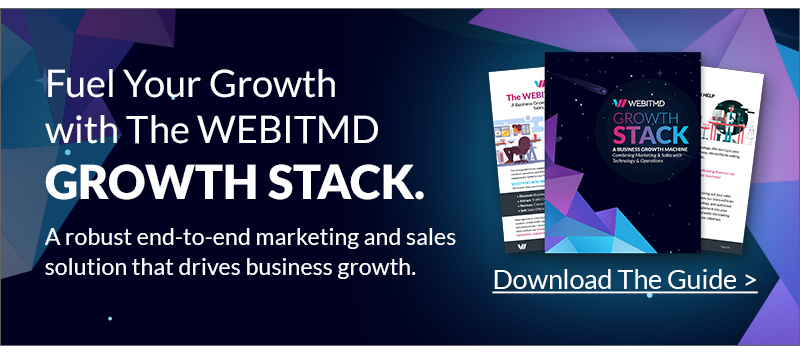If you are in the process of researching the various digital marketing strategies that could help you hit your growth goals, SEO is likely the first one you’ve looked into. After all, it is the most popular marketing strategy, almost always leads to the highest sources of revenue for online sales, and if SEO is performed by a top growth marketing agency, your organic presence can stick in the SERPs for years after a campaign is paused, meaning your acquisition cost is free.
But if your business meets the right criteria (you have a longer sales cycle and higher price point) a growth stack, fueled by a modern SEO strategy, could easily prove to be the better investment with the highest return.
But if you are like most business owners and marketing managers, you likely started searching for SEO agencies with no idea of what growth marketing even is. This article is intended to help members of the C-Suite and internal marketing teams learn all about a custom growth stack, how SEO empowers your ability to grow your business through this approach, and why savvy brands are already getting on board.
What is a Growth Marketing Stack and what is Growth Marketing as an Approach?
A growth marketing stack is a set of strategies and tools strategically chosen and customized to work together towards achieving the same goals. It embarks on a multi-channel approach that uses SEO, paid media, inbound marketing and other strategies to attract traffic, nurture leads, and convert people to revenue. A growth marketing stack is grounded in how marketers understand the process their customer’s buyers go through when making a purchasing decision. Stages from that buyer’s journey are broken down to attract the right traffic, at the right time, and convert them into leads. Then they go through a funnel in which customized content is created that speaks to their needs by offering solutions, and educated them until they are ready to make a confident purchase.
How SEO is Traditionally Viewed in a Growth Stack
Not all digital marketing agencies have the ability to offer growth stacks, and of the ones who do, not all utilize SEO to its full potential. Most SEO expectations in a growth marketing stack treat the strategy as a top-of-funnel traffic generator. And while it does indeed still fulfill this purpose, SEO agencies can do so much more with organic search optimization in a growth marketing campaign by sending organic traffic to every stage of the buyer’s journey.
1. SEO is Full-Funnel Fuel
Growth stacks contain inbound campaigns with various landing pages designed to nurture readers on to the next phase of the buyer’s journey, or convert them on the spot based on where their journey is at, and according to their buyer persona. A savvy SEO agency can send high-quality organic traffic to these specific landing pages, using optimized content that speaks to specific buyer audiences, at a precise stage in their buyer’s journey. That said, SEO can be used to improve results at every phase of the conversion funnel, and is therefore a full-funnel strategy, if executed by the right organic strategists who have a background in marketing psychology and more than a decade of experience in running niche organic search strategies.
2. SEO Blog Clusters and Pillar Pages
Some brands give growth marketing agencies the green light to put any content on their website that will attract high-quality traffic likely to convert. Other brands want to keep their homepage free from text because they love that minimalistic look and they are willing to wait longer to get traffic for the sake of their own personal aesthetic taste.
But SEO can work around this common problem growth marketers face with clients who have a tight grasp on the look and feel of their content.
Pillar pages, unique pages designed to organically rank for target audiences, can be built and added to the site’s navigation. Then, a cluster of blogs can be written to help funnel SEO juice to the pillar page which will improve organic rankings and, if the pillar page has a CTA to a conversion point, be responsible for an increase in sales.
A blog cluster will consist of a number of blogs that all address the same general subject, but each will cover a unique topic and have an original title. Then each blog will link to the pillar page, while internally linking to another blog that’s similar in topics. For example, if a no-kill animal shelter has a blog cluster strategy for their website, and they are targeting people who are interested in getting a pet, the pillar page could be on why adopting is the best solution to getting a cat or dog. Supporting blogs in the cluster could cover topics from “how to tell if an adopted dog will get along with your other pets” to “how to choose the best cat for adoption”, and to “5 reasons why declawing my adopted cat is a bad move.” In this example, you can see how each blog in the cluster addresses a common question people ask when adopting a pet, and by providing solutions to these questions through a blog cluster feeding a pillar page, high-quality traffic will filter in, and pet adoptions will go up as a result.
3. Sharing SEO Data Across Growth Marketing Stacks
SEO can empower a growth stack approach by sharing data. The data that comes in from SEO can help empower paid media targeting efforts, and vice versa. When your growth marketing agency onboards you as a new client, they will begin by building out your CRM and with that will come the creation of data streams. WEBITMD uses HubSpot, and one of many reasons for this is that marketers get data views from all channels, in one convenient screen shot. This allows SEO strategists to look at pockets of HubSpot data that reveal lead sources and the types of content they engaged with that converted them, and use that data to improve organic audience targeting measures.
SEO as a stand-alone service may be an ideal strategy (and all you need) to achieve your growth goals. But if a growth marketing stack makes more sense given your business model and customers, it’s definitely worth exploring.
Download our FREE Guide on the Growth Stack Below
Is SEO as a stand-alone strategy your best investment for your business, or will a custom growth stack improve your bottom line with ongoing year-over-year growth? Download the guide below, give it a read, and call one of our team members to explore your options. We would love to learn all about your products, services, customers, and your revenue goals!










.jpg)



.jpg)





![5 Reports to Elevate Your HubSpot Sales Dashboard [+ Examples]](https://blog.webitmd.com/hs-fs/hubfs/Imported_Blog_Media/6-winning-examples-of-a-hubspot-sales-dashboard-2.png?width=767&name=6-winning-examples-of-a-hubspot-sales-dashboard-2.png)